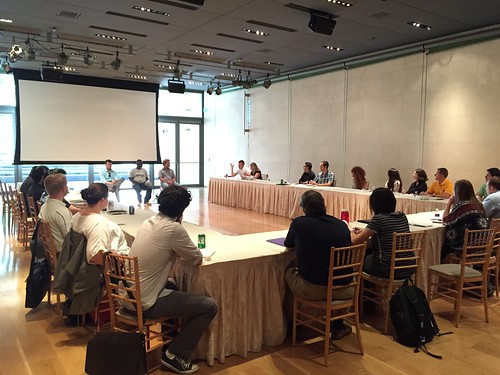 Photo Credit: Andy Moon, 2015 ELP Co-Chair
Photo Credit: Andy Moon, 2015 ELP Co-Chair
Our September session for 2015 AIA
Emerging Leaders Program was held at The Nasher Sculpture Center in downtown
Dallas.
Before our scheduled panelists began, Diego Barrera,
AIA gave us a quick overview of the ACE Mentor Program and how we could get
involved as mentors. The mission of the program is to enlighten high school
students to pursue careers in architecture, engineering and construction.
After Mr. Barrera’s
presentation, we began to discuss September's topic, Community Activism,
and we had two great community forces on hand for discussion. Our distinguished panelists were Patrick Kennedy, CNU AICP,
urban planner and partner at Space Between Design Studio and prominent
founder of the Coalition for a New Dallas, a political action committee, and Daron Babcock, founder of
Bonton Farms, where the collective efforts of the last two ELP classes have been focused on designing the infrastructure of the working urban farm in South Dallas. Not only did we have these two inspirational leaders right in
front of us, Daron brought Patrick Wright, a fellow resident of the Bonton
Community. All three gentlemen inspired us by describing how their forces
for change within the community began, and how the grassroots nature of their
efforts eventually won over widespread support for their initiatives.
Mr. Kennedy's efforts
focused on his work with the Coalition for A New Dallas, a local PAC whose
charge is to better inform community leaders and members of the prospects of
implementing sound transportation and urban design principles in a broader
regional framework. Chiefly, the group's mission was to redirect TxDOT's
efforts towards the rebuilding of the I-345 elevated viaduct that bifurcates
Downtown Dallas and the Deep Ellum/East Dallas area towards a more sustainable
and progressive model that replaces the aging viaduct with an at-grade
boulevard and opens up land for development between Downtown and Deep Ellum, as
well as, more importantly, removing the psychological barrier that the elevated
freeway present to groups vying to bridge the disparate areas into a
more cohesive Dallas. Currently, the PAC's initiative is to engage
political and civic leaders in moving the alternative vision for I-345 forward.
Mr. Babcock and Mr.
Wright offered up their stories behind Bonton Farms in South Dallas, and how
their lives were transformed from ones with [admittedly] little meaning to ones
championing the great cause of offering up solutions for the "food
desert" problems that plague low-income neighborhoods like Bonton, and
addressing the broader problems of reducing crime, recidivism and drugs that
plague these areas and refocusing on these with efforts that
encourage and reward hard work and instilling community pride and cohesion and
a path out of hopelessness.
Beyond sharing their stories, a fruitful discussion was had after their initial introduction. Much appreciation goes out to these gentlemen for sharing some of their time and wisdom with us.

